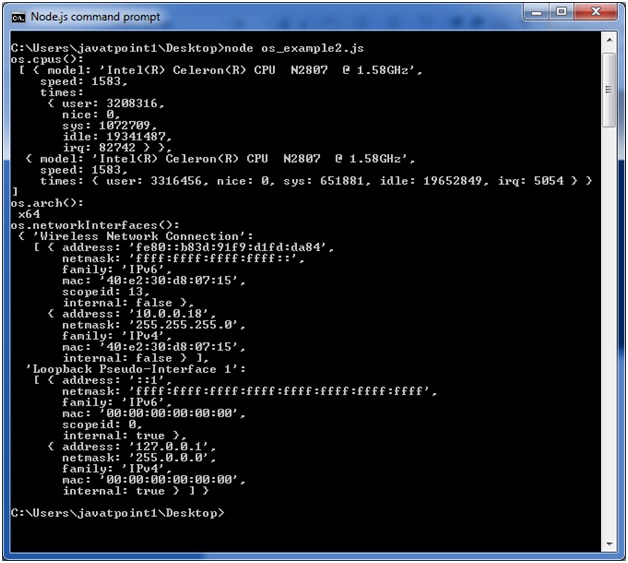📌 相关文章
- Node.js操作系统(1)
- Node.js 操作系统
- Node.js 操作系统常量(1)
- Node.js 操作系统常量
- Node.js 操作系统完整参考
- Node.js 操作系统完整参考(1)
- 操作系统 | 6套
- 操作系统 | 2套(1)
- 操作系统
- 操作系统 |组5(1)
- 操作系统
- 操作系统 | 8套(1)
- 操作系统 |组5
- 操作系统 | 7套
- 操作系统 | 8套
- 操作系统(1)
- 操作系统 | 2套
- 操作系统 | 7套(1)
- Node.js 流
- Node.js-流
- Node.js-流(1)
- Node.js流
- Node.js流(1)
- Node.js 流(1)
- Node.js 操作系统.EOL(1)
- Node.js 操作系统.EOL
- Node.js与Python
- Node.js与Python(1)
- node.js 中的猫鼬 - Javascript (1)
📜 Node.js操作系统
📅 最后修改于: 2020-12-24 03:32:02 🧑 作者: Mango
Node.js操作系统
Node.js OS提供了一些与操作系统相关的基本实用程序功能。让我们看一下常用的函数或方法列表。
| Index | Method | Description |
|---|---|---|
| 1. | os.arch() | This method is used to fetch the operating system CPU architecture. |
| 2. |
os.cpus()
|
This method is used to fetch an array of objects containing information about each cpu/core installed: model, speed (in MHz), and times (an object containing the number of milliseconds the cpu/core spent in: user, nice, sys, idle, and irq). |
| 3. | os.endianness() | This method returns the endianness of the cpu. Its possible values are ‘BE’ for big endian or ‘LE’ for little endian. |
| 4. | os.freemem() | This methods returns the amount of free system memory in bytes. |
| 5. | os.homedir() | This method returns the home directory of the current user. |
| 6. |
os.hostname()
|
This method is used to returns the hostname of the operating system. |
| 7. | os.loadavg() | This method returns an array containing the 1, 5, and 15 minute load averages. The load average is a time fraction taken by system activity, calculated by the operating system and expressed as a fractional number. |
| 8. | os.networkinterfaces() | This method returns a list of network interfaces. |
| 9. | os.platform() | This method returns the operating system platform of the running computer i.e.’darwin’, ‘win32′,’freebsd’, ‘linux’, ‘sunos’ etc. |
| 10. | os.release() | This method returns the operating system release. |
| 11. | os.tmpdir() | This method returns the operating system’s default directory for temporary files. |
| 12. | os.totalmem() | This method returns the total amount of system memory in bytes. |
| 13. | os.type() | This method returns the operating system name. For example ‘linux’ on linux, ‘darwin’ on os x and ‘windows_nt’ on windows. |
| 14. | os.uptime() | This method returns the system uptime in seconds. |
| 15. | os.userinfo([options]) | This method returns a subset of the password file entry for the current effective user. |
Node.js OS示例1
在此示例中,我们包括一些基本功能。创建具有以下代码的名为os_example1.js的文件:
文件:os_example1.js
const os=require('os');
console.log("os.freemem(): \n",os.freemem());
console.log("os.homedir(): \n",os.homedir());
console.log("os.hostname(): \n",os.hostname());
console.log("os.endianness(): \n",os.endianness());
console.log("os.loadavg(): \n",os.loadavg());
console.log("os.platform(): \n",os.platform());
console.log("os.release(): \n",os.release());
console.log("os.tmpdir(): \n",os.tmpdir());
console.log("os.totalmem(): \n",os.totalmem());
console.log("os.type(): \n",os.type());
console.log("os.uptime(): \n",os.uptime());
打开Node.js命令提示符并运行以下代码:
node os_example1.js

Node.js OS示例2
在此示例中,我们包括其余功能。使用以下代码创建一个名为os_example2.js的文件:
文件:os_example2.js
const os=require('os');
console.log("os.cpus(): \n",os.cpus());
console.log("os.arch(): \n",os.arch());
console.log("os.networkInterfaces(): \n",os.networkInterfaces());
打开Node.js命令提示符并运行以下代码:
node os_example2.js
